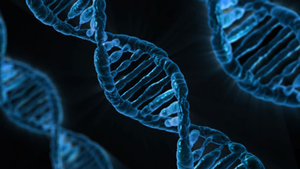DNA
Contents
Key Stage 3
Meaning

An artists impression of a DNA molecule.
DNA is the molecule inside an organism that provides instructions on how to build that organism and how the cells behave inside the organism.
About DNA
- DNA is found in the nucleus.
- DNA coils together to make chromosomes.
- DNA is passed from parent to offspring.
- DNA controls most of our physical appearance.
- DNA determines your eye colour, nose shape, height, skin colour and whether you are male or female. All of these things can be affected by environment as well, but the DNA provides the original instructions on how to build you.
- DNA has a double helix structure, which means it is shaped like twisted ladder.
Discovery of DNA
- DNA was first discovered in 1869, but at the time nobody knew how it worked or what its structure was.
- In 1928 an experiment with DNA showed that it was responsible for heredity.
- In 1953 Francis Crick and James Watson found evidence that DNA was a long double helix molecule.
Key Stage 4
Meaning
DNA is a polymer made of nucleotides which provides instructions for the structure and behaviour of an organism.
About DNA
- DNA is formed by the polymerisation reaction between nucleotide monomers.
- DNA stands for deoxyribose nucleic acid.
- DNA is found in the nucleus of eukaryotes and floating freely in the cytoplasm of prokaryotes.
- DNA in eukaryotes coils together to make chromosomes.
- DNA is arranged in genes that control most of our physical appearance.
- DNA has a double helix structure, which means it is shaped like twisted ladder.
- DNA is made from four nucleotide bases called Adenine, Thymine, Cytosine, and Guanine referred to as A, T, C and G.
- The nucleotide bases are arranged in complementary pairs. Adenine and Thymine pair up on opposite sides of the DNA strand. The same is true for Cytosine and Guanine. When the strand is pulled into two pieces this allows the DNA to make two exact copies of itself. So if one side of the strand has the code AAAACCCTTG then the other will have the code TTTTGGGAAC.
References
AQA
References
AQA
- DNA (deoxyribonucleic acid), pages 14-5, 22-5, 29, 236-49, 272-3, 301, 311, GCSE Biology; Student Book, Collins, AQA
- DNA (deoxyribonucleic acid), pages 174-175, GCSE Chemistry; Third Edition, Oxford University Press, AQA
- DNA (deoxyribonucleic acid), pages 193-4, GCSE Chemistry, Hodder, AQA
- DNA (deoxyribonucleic acid), pages 202-205, 235, GCSE Biology; Third Edition, Oxford University Press, AQA
- DNA (deoxyribonucleic acid), pages 3, 19, GCSE Combined Science Trilogy 1, Hodder, AQA
- DNA (deoxyribonucleic acid), pages 33-4, GCSE Combined Science Trilogy 2, Hodder, AQA
- DNA (deoxyribonucleic acid); barcode, page 311, GCSE Biology; Student Book, Collins, AQA
- DNA (deoxyribonucleic acid); evolutionary tree, page 311, GCSE Biology; Student Book, Collins, AQA
- DNA (deoxyribonucleic acid); mitochondrial, page 242, GCSE Biology; Student Book, Collins, AQA
- DNA (deoxyribonucleic acid); structure, page 244-5, GCSE Biology; Student Book, Collins, AQA
- DNA, page 247, GCSE Chemistry, CGP, AQA
- DNA, page 84, GCSE Chemistry; The Revision Guide, CGP, AQA
- DNA, pages 122, 286, GCSE Physics; Student Book, Collins, AQA
- DNA, pages 15, 66, GCSE Combined Science; The Revision Guide, CGP, AQA
- DNA, pages 15, 84, 85, GCSE Biology; The Revision Guide, CGP, AQA
- DNA, pages 3, 183-6, GCSE Biology, Hodder, AQA
- DNA, pages 33, 204, 205, GCSE Combined Science Trilogy; Biology, CGP, AQA
- DNA, pages 33, 244-246, GCSE Biology, CGP, AQA
- DNA, pages 88, 226-7, 252-3, 257, 283, GCSE Chemistry; Student Book, Collins, AQA
- DNA; nucleotides, page 85, GCSE Biology; The Revision Guide, CGP, AQA
- DNA; structure of, page 246, GCSE Biology, CGP, AQA
Edexcel
- DNA, page 100, GCSE Chemistry; The Revision Guide, CGP, Edexcel
- DNA, page 27, GCSE Combined Science; The Revision Guide, CGP, Edexcel
- DNA, page 292, GCSE Chemistry, CGP, Edexcel
- DNA, page 86, GCSE Physics, Pearson Edexcel
- DNA, pages 34-36, GCSE Biology; The Revision Guide, CGP, Edexcel
- DNA, pages 4, 10, 40, 42-43, 350, GCSE Combined Science, Pearson Edexcel
- DNA, pages 4, 10, 52, 54-55, GCSE Biology, Pearson, Edexcel
- DNA, pages 58, 89-91, 93, 95, GCSE Biology, CGP, Edexcel
- DNA; code, page 55, GCSE Biology, Pearson, Edexcel
- DNA; extracting from fruit, page 91, GCSE Biology, CGP, Edexcel
- DNA; extraction from fruit, page 34, GCSE Biology; The Revision Guide, CGP, Edexcel
- DNA; extraction, pages 56-57, GCSE Biology, Pearson, Edexcel
- DNA; recombinant, page 65, GCSE Combined Science, Pearson Edexcel
- DNA; recombinant, page 89, GCSE Biology, Pearson, Edexcel
- DNA; replication, pages 30, 53, GCSE Biology, Pearson, Edexcel
- DNA; structure, page 54, GCSE Biology, Pearson, Edexcel
- DNA; structure, page 90, GCSE Biology, CGP, Edexcel
OCR
- DNA, page 91, Gateway GCSE Chemistry; The Revision Guide, CGP, OCR
- DNA, pages 14, 23, 48, 50, Gateway GCSE Combined Science; The Revision Guide, CGP, OCR
- DNA, pages 15, 16, 28, 66-68, 89, Gateway GCSE Biology; The Revision Guide, CGP, OCR
- DNA; bases, pages 29, 163, Gateway GCSE Biology, Oxford, OCR
- DNA; genetic engineering, pages 202-203, Gateway GCSE Biology, Oxford, OCR
- DNA; genetics, pages 164-165, Gateway GCSE Biology, Oxford, OCR
- DNA; mutations, pages 162-163, Gateway GCSE Biology, Oxford, OCR
- DNA; phylogeny, page 175, Gateway GCSE Biology, Oxford, OCR
- DNA; plasmids, page 21, Gateway GCSE Biology, Oxford, OCR
- DNA; profiles, pages 164, 221, Gateway GCSE Biology, Oxford, OCR
- DNA; replication, pages 64-65, Gateway GCSE Biology, Oxford, OCR
- DNA; sequencing DNA, pages 53, Gateway GCSE Combined Science; The Revision Guide, CGP, OCR
- DNA; species comparison, page 171, Gateway GCSE Biology, Oxford, OCR
- DNA; structure of, pages 28-29, 164, Gateway GCSE Biology, Oxford, OCR
- DNA; transcription, page 30, Gateway GCSE Biology, Oxford, OCR
